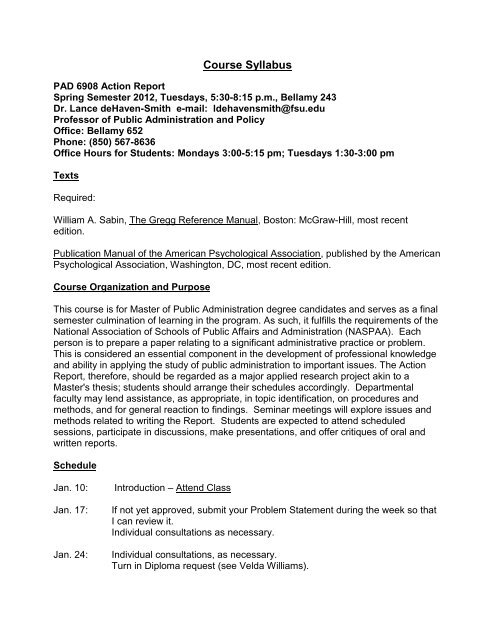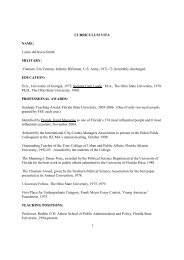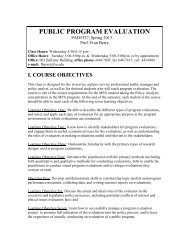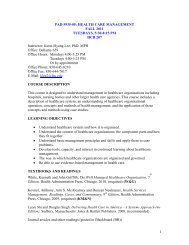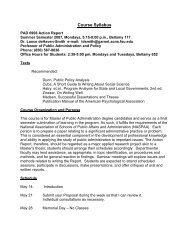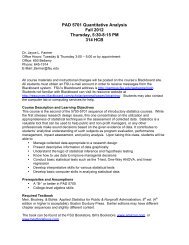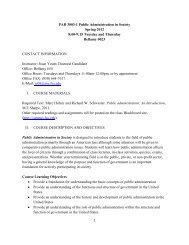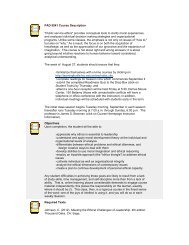Course Syllabus - Askew School of Public Administration and Policy ...
Course Syllabus - Askew School of Public Administration and Policy ...
Course Syllabus - Askew School of Public Administration and Policy ...
Create successful ePaper yourself
Turn your PDF publications into a flip-book with our unique Google optimized e-Paper software.
<strong>Course</strong> <strong>Syllabus</strong>PAD 6908 Action ReportSpring Semester 2012, Tuesdays, 5:30-8:15 p.m., Bellamy 243Dr. Lance deHaven-Smith e-mail: ldehavensmith@fsu.eduPr<strong>of</strong>essor <strong>of</strong> <strong>Public</strong> <strong>Administration</strong> <strong>and</strong> <strong>Policy</strong>Office: Bellamy 652Phone: (850) 567-8636Office Hours for Students: Mondays 3:00-5:15 pm; Tuesdays 1:30-3:00 pmTextsRequired:William A. Sabin, The Gregg Reference Manual, Boston: McGraw-Hill, most recentedition.<strong>Public</strong>ation Manual <strong>of</strong> the American Psychological Association, published by the AmericanPsychological Association, Washington, DC, most recent edition.<strong>Course</strong> Organization <strong>and</strong> PurposeThis course is for Master <strong>of</strong> <strong>Public</strong> <strong>Administration</strong> degree c<strong>and</strong>idates <strong>and</strong> serves as a finalsemester culmination <strong>of</strong> learning in the program. As such, it fulfills the requirements <strong>of</strong> theNational Association <strong>of</strong> <strong>School</strong>s <strong>of</strong> <strong>Public</strong> Affairs <strong>and</strong> <strong>Administration</strong> (NASPAA). Eachperson is to prepare a paper relating to a significant administrative practice or problem.This is considered an essential component in the development <strong>of</strong> pr<strong>of</strong>essional knowledge<strong>and</strong> ability in applying the study <strong>of</strong> public administration to important issues. The ActionReport, therefore, should be regarded as a major applied research project akin to aMaster's thesis; students should arrange their schedules accordingly. Departmentalfaculty may lend assistance, as appropriate, in topic identification, on procedures <strong>and</strong>methods, <strong>and</strong> for general reaction to findings. Seminar meetings will explore issues <strong>and</strong>methods related to writing the Report. Students are expected to attend scheduledsessions, participate in discussions, make presentations, <strong>and</strong> <strong>of</strong>fer critiques <strong>of</strong> oral <strong>and</strong>written reports.ScheduleJan. 10:Jan. 17:Jan. 24:Introduction – Attend ClassIf not yet approved, submit your Problem Statement during the week so thatI can review it.Individual consultations as necessary.Individual consultations, as necessary.Turn in Diploma request (see Velda Williams).
Jan. 31:Feb. 7:Feb. 14:Feb. 21:Feb. 28:Mar. 6:Mar. 13:Mar. 20:Mar. 27:Apr. 3:Apr. 10:Apr. 17:Individual consultations, as necessary.Individual consultations, as necessary.Attend class to submit 1 st draft <strong>of</strong> report.Individual consultations, as necessary. Reviews <strong>of</strong> 1 st drafts will be placed instudent foldersIndividual consultations, as necessarySpring Break – No ClassesAttend class to submit 2nd draft <strong>of</strong> report.Action Report presentations to class.Remaining Action Report presentations to class.Last day to submit final reportIndividual consultations, as necessaryIndividual consultations, as necessarySubmission RequirementsAll papers should be stapled in the upper left h<strong>and</strong> corner <strong>and</strong> submitted in a "two pocket"folder. In the left section, place the most recent instructor-corrected copy (earlier draftsshould not be included); in the right section, the newest draft with appropriate checklist.Be sure to put your telephone number(s) <strong>and</strong> e-mail address on the front <strong>of</strong> the folder.This class is structured to ensure progress toward course completion <strong>and</strong> relies onindividual consultations <strong>and</strong> student presentations. Not meeting deadlines demonstratesinadequate planning. Please do not ask for special favors; brief extensions will be grantedonly on the basis <strong>of</strong> extreme, documented emergencies.Do not expect the instructor to copyedit <strong>and</strong> pro<strong>of</strong> your work. Names <strong>of</strong> pro<strong>of</strong> readers <strong>and</strong>editors can be obtained from the English Department (644-4230).The final Action Report that is submitted should be bound <strong>and</strong> include an electronic copy<strong>of</strong> the manuscript. Kinkos, Target, <strong>and</strong> similar outlets can provide binding. The electroniccopy should be on CD or floppy disc.
Action Report St<strong>and</strong>ardsThe MPA Program is to "produce pr<strong>of</strong>essionals capable <strong>of</strong> intelligent <strong>and</strong> creativeanalysis, communication, <strong>and</strong> action in the public sector context." The Action Report, asnoted earlier, is the capstone <strong>of</strong> this educational experience. Accordingly, it provides theopportunity for students to demonstrate ability to define <strong>and</strong> diagnose decision situations,collect relevant data, perform logical analysis, develop alternatives, implement a course <strong>of</strong>action, <strong>and</strong> evaluate results; organize <strong>and</strong> communicate clearly to a variety <strong>of</strong> audiencesthrough formats including verbal presentations, technical reports, <strong>and</strong> statistical charts,graphs, <strong>and</strong> tables (NASPAA St<strong>and</strong>ards).Action Report LayoutThe Report should be: from 25 to 35 manuscript pages (plus appendices), pr<strong>of</strong>essionallytyped <strong>and</strong> <strong>of</strong> a quality comparable to a monograph published by university servicebureaus, government agencies, legislative committees, or pr<strong>of</strong>essional organizations.Following the title page, letter <strong>of</strong> transmittal, table <strong>of</strong> contents, <strong>and</strong> a brief executivesummary (describing the problem, the methods used in the study, alternatives considered,<strong>and</strong> the recommended action), the Report should be presented as described below.I. Problem Statement (two pages in a 30-page report (not including front matter,references, <strong>and</strong> appendices))Concise statement <strong>of</strong> the problem or question being investigated;Brief discussion <strong>of</strong> issues surrounding the problem <strong>and</strong>/or proposed actionsExplanation <strong>of</strong> why the problem or question is significant in public administration.II. Background <strong>and</strong> Literature Review (about six pages)Backgroundo The nature <strong>of</strong> the problem should be elaborated. How did the problemevolve? How has it changed over time?o What is the current status <strong>of</strong> the problem?o Specify the context in which the problem occurs <strong>and</strong> its timeliness for publicadministration.Literature Reviewo Summarize the literature. Include academic research <strong>and</strong> major reports <strong>of</strong>government agencies.o Describe how the present study relates to existing literature. Whatguidance does the literature provide? What issues remain that are pertinentto the problem under analysis?
Violations <strong>of</strong> the Academic Honor Code are delineated in Chapter 8 <strong>of</strong> the FacultyH<strong>and</strong>book, as follows (8.22.1 (b) ):..1. During examinations, violations <strong>of</strong> the Academic Honor Code shall include referringto information not specifically condoned by the instructor. It shall further includereceiving information from a fellow student or another unauthorized source.2. Regarding academic assignments, violations <strong>of</strong> the Academic Honor Code shallinclude representing another's work or any part there<strong>of</strong>, be it published orunpublished, as one's own. It shall also include presenting or submitting anyacademic work in a manner that impairs the instructor's ability to assess thestudent's academic performance. For example, plagiarism includes failure to usequotation marks or other conventional markings around material quoted from anysource.3. Violations <strong>of</strong> the Academic Honor Code shall include obtaining, distributing, orreferring to a copy <strong>of</strong> an examination which the instructor/department has notauthorized to be made available for such purpose.4. Violations <strong>of</strong> the Academic Honor Code shall include any act which impedes theability <strong>of</strong> other students to have fair access to materials assigned or suggested bythe instructor. For example, removal or destruction <strong>of</strong> library or other sourcematerials violates the Academic Honor Code.5. Academic dishonesty shall include tampering with another student's work orimpairing in any way the instructor's ability to assess the academic performance <strong>of</strong>another student.6. Violations <strong>of</strong> the Academic Honor Code shall include alteration <strong>of</strong> grades or anyother records related to the academic performance <strong>of</strong> students. This shall alsoinclude submitting any false records in order to gain admission to the University.7. Violations <strong>of</strong> the Academic Honor Code shall include assisting, attempting to assist,or conspiring to assist another student in committing the <strong>of</strong>fenses as outlinedabove.8. Violations <strong>of</strong> the Academic Honor Code shall include attempting to commit any<strong>of</strong>fense as outlined above.Students should pay special attention to paragraph 2, above. Plagiarism on anydraft <strong>of</strong> the Action Report may result in a failing grade for the course.ADA <strong>Policy</strong>Students with disabilities needing academic accommodation should (1) registerwith <strong>and</strong> provide documentation to the Student Disability Resource Center; <strong>and</strong> (2) bring aletter to the pr<strong>of</strong>essors indicating the need for accommodation <strong>and</strong> what type. This shouldbe done during theGrades
Grades for the course will be based on a multidimensional evaluation <strong>of</strong> the ActionReport. The criteria <strong>and</strong> the weight assigned to them are as follows:Conceptualization <strong>and</strong> Writing (30%)Clarity, cogency <strong>of</strong> problem conceptualizationRelevance <strong>and</strong> range <strong>of</strong> evaluative criteriaClarity <strong>and</strong> grammatical correctness <strong>of</strong> writingResearch (30%)Scope <strong>and</strong> organization <strong>of</strong> background <strong>and</strong> literature reviewQuality <strong>of</strong> analysis <strong>and</strong> interpretationRecommendations (20%)Consistency in application <strong>of</strong> evaluative criteria.Appropriateness <strong>of</strong> conclusions <strong>and</strong> recommendations.Presentation (20%)Organization <strong>and</strong> conciseness <strong>of</strong> presentationQuality <strong>of</strong> speakingGrade equivalencies are: 100-93=A, 92-90=A-. 89-87=B+, 86-83=B, 82-80=B-,79-77=C+, 76-73=C, 72-70=C-, 69-67=D+, 66-63=D, 62-60=D-, 59-0=F. In thecomputation <strong>of</strong> final grades, all decimals from .5 <strong>and</strong> above are rounded up, <strong>and</strong> all belowthis are rounded down.


